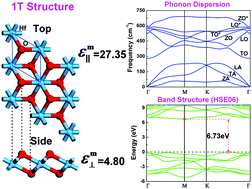A honeycomb-like monolayer of HfO2 and the calculation of static dielectric constant eliminating the effect of vacuum spacing
Abstract
A novel dielectric material of monolayer 1T-HfO2 has been investigated using first-principles calculations. The stability of 1T-HfO2 has been proved by both phonon dispersions and ab initio molecular dynamics calculations, although its 2H structural counterpart is dynamically unstable. 1T-HfO2 monolayer can be cleaved from the (111) facet of cubic HfO2. It is found that 1T-HfO2 has a large band gap of 6.73 eV, exceeding the band gaps of h-BN (5.97 eV) and bulk HfO2 (5.7 eV). From the microscopic perspective of dielectric polarization, we provide an explanation for the dependence of the dielectric constant directly calculated from the supercell of a two-dimensional (2D) system on the variable vacuum spacing, and we thus obtain a rational method for accurately evaluating the dielectric constants of 2D materials based on the calculated value obtained from a supercell to meet periodic conditions. Our derivation can be verified by the data fitting of a series of calculations with different vacuum spacings. The static dielectric constants of 1T-HfO2 along the in-plane and out-of-plane directions are 27.35 and 4.80, respectively, higher than those of monolayer h-BN. The large band gap and high dielectric constant make 1T-HfO2 a promising candidate as a dielectric layer in 2D field-effect transistors and heterojunctions.



 Please wait while we load your content...
Please wait while we load your content...